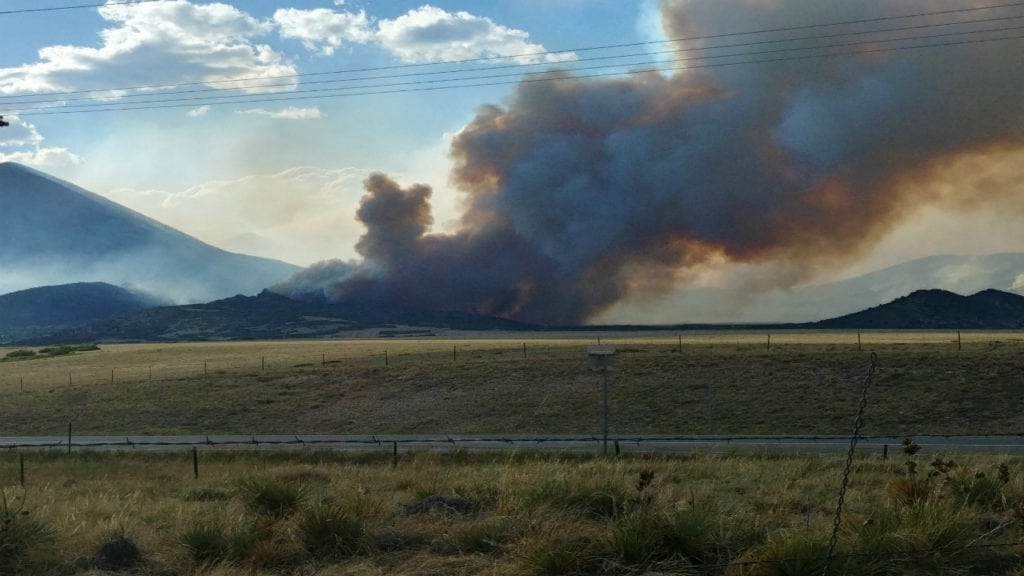LA VETA – Colorado’s second-largest wildfire is still burning nearly two months later.
The Spring Fire remains at 93 percent containment with more than 108,000 acres burned. More than 100 families lost their homes, too.
Now that the bulk of firefighting activity has died down, fire officials told News 5 the impact of mitigation was clear throughout the burn scar. There’s a steady mix of mitigation across the burn scar too, because 80 percent of the land is privately owned by people with varying views on mitigation.

Off Highway 12 and just north of Cuchara lies the Pinehaven subdivision. John Ford and his family have owned a cabin there for more than two decades.
“People love their trees here,” Ford said. “The name of the development is Pinehaven. It was a place to keep the trees and keep them nice.”
While the Fords have mitigated some trees around their property, three trees stand tall right next to the cabin. The deck was built around them, and the Fords have no plans to take them down.
“They’re almost a part of the house, so they’ll probably stay until they have some disease issues or something like that,” Ford said.
In fact, when the Fords purchased the property, the homeowners association told them they needed a permit to cut any tree down.
But with more homes built into the wildland urban interface comes a different train of thought, as massive wildfires, like the Spring Fire, threaten more families and values than ever before.
“Due to our drought, due to our topography, due to the fuel loading, everything that you can imagine that would fuel a massive wildfire is what we have here,” said David Detray, chief of the La Veta Fire Protection District.
La Veta Fire was one of the first responding agencies when the Spring Fire jumped the county line.
Volunteer Firefighters Derek Sokoloski, who also works for the Colorado State Forest Service, saw it happen.
“The fire was spotting anywhere from a half-mile to a mile, and maybe a little more than a mile out in front of itself, so very extreme fire conditions,” Sokoloski said.
The fire was plume-dominated — burning hot and heavy through the crowns of trees — meaning firefighters couldn’t get as close as they’d like to for safety concerns. In the meantime, homeowners watches from the closest vantage points they could find.
But to the crews in the thick of the firefight, especially the structure protection strike teams, like Sokoloski worked on, one thing was clear: more mitigation could have saved some of the 100-plus structures no longer standing.
“The indications of how the fire burned is evident now on looking back at the burn scar, where you can see where active management had been done, the fire effects are lesser than where active management hadn’t been done,” Sokoloski said.
The fire district has 13 FireWise communities with plenty of room for improvement, even at the county level.
Huerfano County’s Emergency Multi-Hazard Mitigation Plan, released in May 2018, shows the county’s commitment to the regulation of projects that would degrade or threaten the existing environmental quality. It also includes language to regulate development that could diminish the scenic beauty of the region.
That would include projects like mitigation that would prevent ground fuels from leading flames into the crowns of trees, or logging, which would space out the crowns for a healthier forest.
“When you think about selling prevention, that’s a hard sell, unless you have an event like this, a catastrophic event that we had,” Detray said.
That work would also give firefighters the chance to save properties, even during a fire moving in all directions.
What was once a tough sell is now viewed by many as a standard homeowner duty that comes with living in the forest — as the community, and the landscape, deal with their new normal.
“I think the need was always there,” Ford said, “I don’t think it impacted that and made any difference. It just refocused it. So, we’ll work harder to do things quicker now.”
Detray told News 5 his phone has rang essentially nonstop following the fire for mitigation assessments, both return calls and new assessments.
However, that work is expensive to do. The Fords said they paid several thousand dollars for the removal of just a handful of trees.
That’s why Huerfano County is currently working to obtain both state and federal grants that would help pay for more mitigation work to be done.

